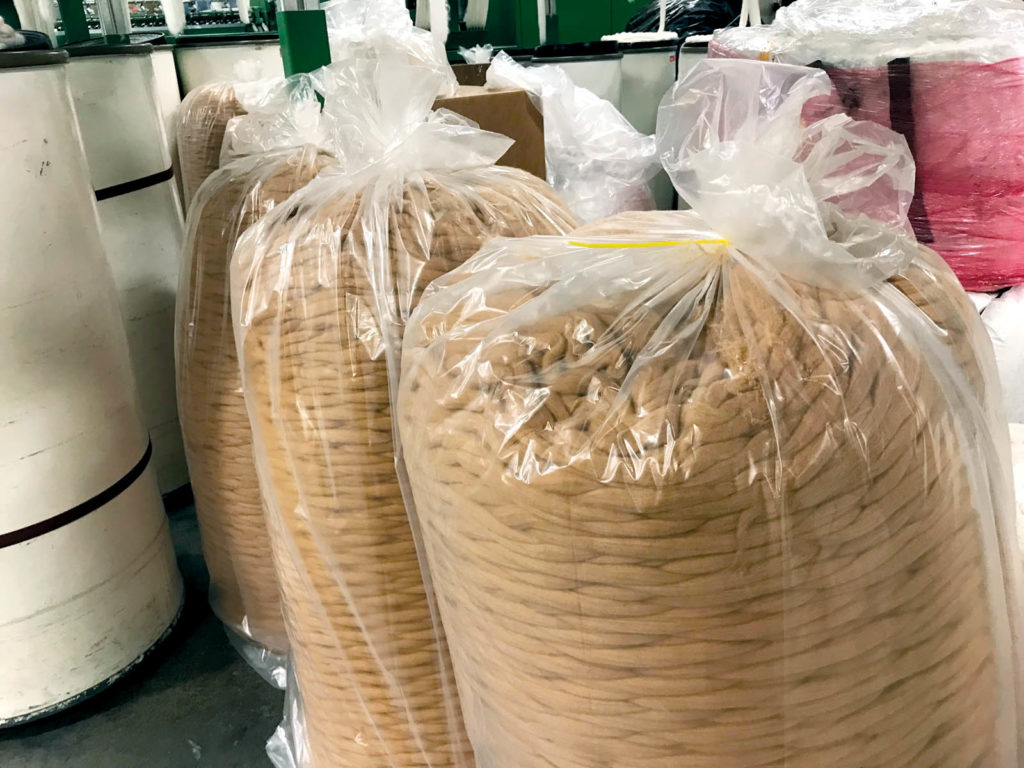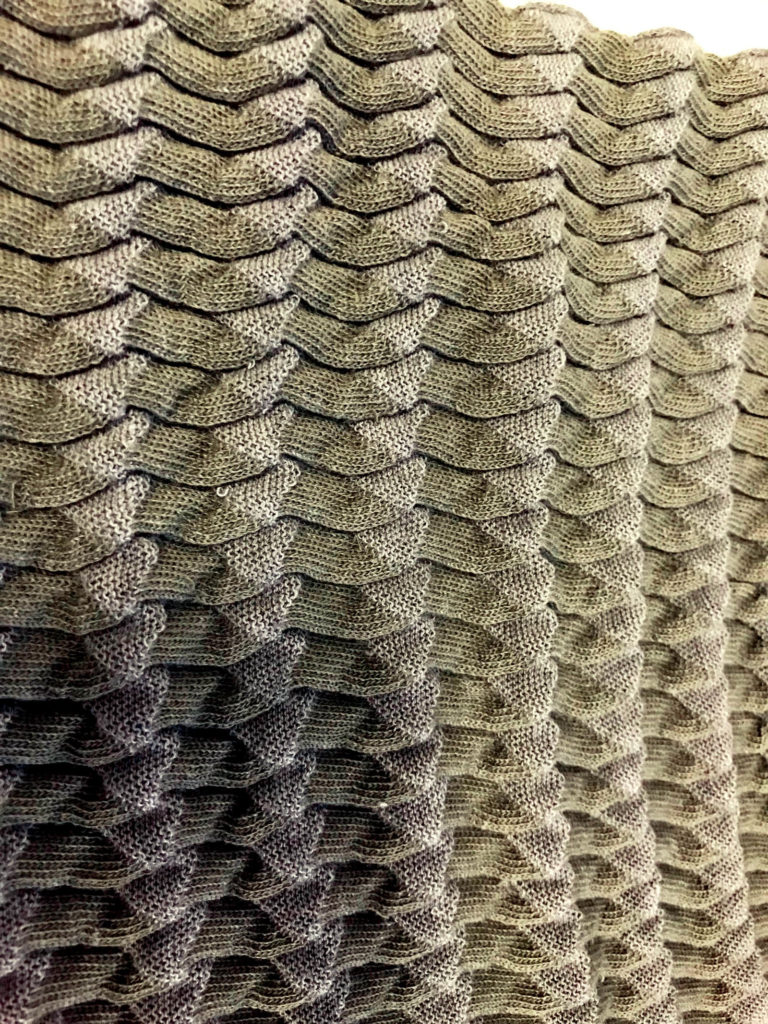
IFAI’s Smart Fabric Summit returned to an in-person event with a new location at North Carolina State University (NC State), its producing partner. This choice allowed for adding another day of activities that included student demonstrations and tours of the Zeis Textiles Extension complex and the Nano-EXtended Textiles lab (NEXT) at the Wilson College of Textiles on the NC State campus.
Zeis director Dr. Andre West noted in his guided tour of the facility that the university has facilities for manufacturing fiber and yarn, the ability to manufacture a variety of knits and wovens and to produce various nonwovens, all in its textile complex. Testing and research labs offer additional capabilities for both student and faculty-generated projects, as well as making a full range of textile production operations available to the industry. According to West, NC State is the only educational institution in the country that has all these capabilities.
The college’s NEXT lab is a focused space for students to pursue their interests in materials engineering, particularly as it involves the design of smart textile platforms “that enable improved materials integration of sensors, energy harvesting, energy storage, and communication devices,” according to the lab’s website.
The NEXT lab uses a “technology innovation through engineering design approach” that includes research in materials, textile electronic systems and student projects that are an integral part of their education in textile technologies. Students presented summaries of projects they are now working on as part of the lab tour.
Student Research Showcase
Meanwhile, a Student Research Showcase was available for attendees to peruse projects underway, with time for unstructured conversations with the researchers. Among them was an advanced, durable textile designed for combat shown by Ph.D. candidate Zoe Newman. In addition to its flame retardance and superior moisture management, the textile has highly stretchable auxetic properties. Auxetic materials do the opposite of materials, generally, and get thicker when stretched.
Ph.D. candidate Beth Kirkwood presented her study concerning knitting conductive yarns. Using a novel three-point bending test for yarn, Kirkwood has developed the basis for a new predictive yarn model simulating the knitting process, which includes machine parameters such as speed, stitch length and gauge.
Walaa Enab, a third-year doctoral student, at Wilson College of Textiles, Fibrous and polymer science department, is working on a unique technique for embedding aligned sheets of carbon nanotubes (CNTs) into the interlaminar region of laminated composite structures to examine the CNTs sheets’ ability to improve the transverse mechanical properties.
Students also presented new designs for monitoring sensors in health and wellness applications (see “Breakthroughs,” p. 16, for more).
The ASSIST partnership
Elena Veety, education director and operations manager, ASSIST Center at NC State described the university’s center, which is headquartered at the university, but the center has several other partnering institutions.
The center’s research areas include energy harvesting and storage, low-power sensing, low-power electronics, e-textiles, and system integration and data. While much of the research underway has applications in the health and wellness market for people, the center also does research in animal health, and agriculture exploring “wearables for plants.” It also offers rapid prototyping capabilities.
The Center’s researchers are always looking to future developments, even though “integration of sensing in textiles is still a challenge.” Veety says, “Our vision is not just wearables, [but] being able to implement multi-modal data streams.”

Assessing the industry
The Summit invested a good portion of its time in taking stock of the state of the smart fabrics industry. Dr. David Hinks, dean of the Wilson College of Textiles, moderated a panel that generated a lively conversation between the panel participants and the audience.
Tanya Wade, entrepreneur intake administrator, Manufacturing Solutions Center, Conover, N.C., made note of the acute need to find workers. “All of our manufacturers that we work with, that’s the number one problem they face,” she says.
Audience members echoed the need for workers and other resources. “Where do you find the technicians?” one asked. “It’s going to take all of us—an army of all of us—to bring textile manufacturing back to the U.S.”
This points to the need for industry participants to assist each other. But how? Wade told the audience to “expect to be a resource,” and noted the importance of having industry participants “reach out and say what they need and what they have.”
Better use of new technology and automation was also discussed as a way to move smart fabrics more quickly into the mainstream. More sustainable materials and practices can help this effort, says Dr. Michael A. Saltzberg, global business director, Dupont Biomaterials, by moving from oil- and gas-based materials to agri-based, biomaterials that the U.S. can provide.
“The world is moving toward more sustainable materials,” Salzberg says. This “de-fossilization,” or movement away from fossil-based materials, is particularly important. “I don’t think we’re going to recycle our way out of this. … The U.S. ought to focus on how to become the leader. Brands and consumers want this,” he says.
“The engine in the United States is small businesses,” Hinks believes, and can offer “tremendous opportunity for startup companies both domestic and for international businesses to invest here.” Once again, “The key is to have a talent supply,” he added.
Bringing industry participants together and getting the needed talent for that to happen involves degree programs and workshops, yes, but attracting talent should also start at the high school level. “NC State and the community college system can be a conduit for that needed supply of talent,” he says.
Making a stronger U.S. industry
The closing keynote address was a Q & A with Jennifer Knight, deputy assistant secretary for textiles, consumer goods and materials (TCGM), U.S. Dept. of Commerce. Dr. West posed the questions and turned first to continuing the discussion of workforce shortages and how to make the workforce grow.
“The kind of work going on at the local level is really where it’s at—where people get training, and then there’s a job,” Knight says. The $500 million Good Jobs Challenge has had more than 500 applicants, she says. “That should go a long way toward strengthening the program.”
The loss of experienced workforce and industry leaders is also looming with many industry experts nearing retirement. “We need to develop the next generation of industry experts,” she says.
The question of the domestic production of PPE was and still is on everyone’s minds. West asked what the Biden Administration is doing to support the domestic production of PPE. She first thanked all those companies that pivoted to make it, adding that they “did a fantastic job.”
But the U.S. must work for a more sustainable public health supply chain, she noted, with the Made in America Office supporting that effort. However, the question is, she says, “Can anybody sustain a business just making PPE?”
When asked about the Biden Administration’s priorities for the industry’s future, Knight responded that the priorities are to see the U.S. textile industry become stronger and more resilient. This involves supporting growth in the Western Hemisphere. It is also important, Knight says, to “find a way for our IP to stay home.” This means commercializing goods in the U.S. or with our allies.
Knight pointed specifically to several companies committed to development in Central America, including a multimillion-dollar investment by global yarn manufacturer Parkdale Mills in a new yarn plant in Honduras. This will help alleviate supply chain issues, support the local economy and encourage other manufacturers to open facilities closer to U.S. textile companies needing those products.
This raises the question of convincing an investor to pay for new equipment anywhere, because the return on investment can take, in fact, many years.
“That’s a tough problem,” she says, “But the success of one encourages others,” and once again pointed to the facility investment made by Parkdale Mills in Honduras. “Its success will encourage others; a rising tide raises all boats,” she adds.
In closing, Knight encouraged the audience to use the services available through her office to find information and support. “Because textiles were so important for so long, OTEXA has an amazing database,” she says. “Please contact us.”
Janet Preus is the senior editor of Advanced Textiles Source and a contributing editor for Specialty Fabrics Review.
 TEXTILES.ORG
TEXTILES.ORG


